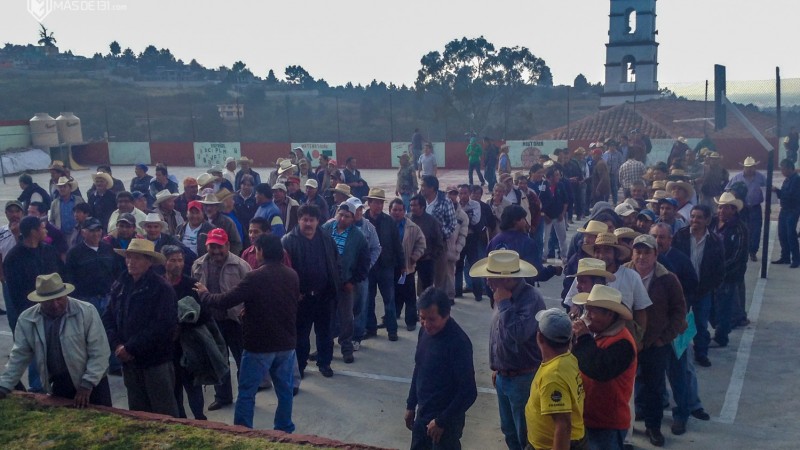Featured Image: Like Cheran, Michoacán, and the Zapatista Caracoles of Chiapas, the Ñätho community of Huitzizilapan have exercised their sovereignty and voted to form their own communal assembly. Photo: Más de 131.
By Mas de 131 / Global Voices
Translated by Glenn Bower
Huitzizilapan, whose old name is N’dete, which means “big town”, currently encompasses 12 indigenous Otomí-Ñätho communities living in the area between the two large cities of Mexico City and Toluca.
A year ago, its people organized themselves to defend their forests, a movement that ultimately led them to elect their own representatives free from the influence of any political party on 7 December 2015.
That day, the indigenous people waited for the arrival of the Agrarian Ombudsman, the authority which can give power to assemblies formed on communally owned lands in Mexico.
However, the ombudsman never arrived, citing an accident as the reason.
Meanwhile, members of the National Human Rights Commission, who were invited by the comuneros (a Mexican term for members of an agrarian community) to document the assembly, left without warning.
This did not stop the indigenous community members from exercising their rights in line with convention 169 of the International Labour Organization, the Mexican Constitution and agrarian legislation.
During the assembly, by a show of hands, they unanimously choose the “candidates of the people.”
The Ñätho, however, say that they were forced to confront a new assembly convened by the Agrarian Ombudsman without legal grounds on 18 January 2016.
The Ñätho worried that the local government and the pro-government Institutional Revolutionary Party would impose another parallel authority instead of the authority which the people already had elected.
They therefore decided to make efforts to reinforce their vote.
“We are getting organised and visiting all the comuneros so we can win again,” said Abundio Rivera, one of the local leaders.
In a statement released on 12 January, the comuneros criticised the town’s former authorities, who had links to the Institutional Revolutionary Party, for handing out 2,000 Mexican pesos to each person to persuade them not to support the chosen “candidates of the people.”
“We are working on increasing awareness,” stressed Rivera. And they did, on 18 January 2016 they won again.
Since 2003, the federal government has set up registers of comuneros in agrarian and communal centres around the country.
In Huitzizilapan, there are 904 comuneros who make decisions involving the land. Since then, all kinds of projects have been imposed by the communal authorities, without any prior consultation with the people.
The idea behind the 2014 movement and the formation of a group of candidates from open assemblies held in the town was to reverse the environmental destruction and protect the integrity of the Huitzizilapan people’s lands.
Once elected on 7 December, the first words of the new commissariat were:
We all know the great difficulties facing the community, we must care for our land, our water and our forest as well as deal with other issues. To me it seems we must keep those citizens of San Lorenzo whether they be at home or away, in mind. Let us give them the chance to voice their vote.
Another comunero went even further in saying:
I will fight for the autonomy of the people, not just the chance to vote. I will open the doors to the people and recover the autonomy we had 15 years ago, because our children have the right to decide what happens to their land and forest, independent of the Agrarian Ombudsman.
The president’s order
Along with its neighbours, Xochicuautla and Ayotuxco, Huitzizilapan faces the construction of the Toluca-Naucalpan highway, which was contracted to a corporation owned by Juan Armando Hinojosa, one of the businessmen most favored by Mexican President Enrique Peña Nieto’s government.
At the beginning of 2015, the former town commissioner and member of the Institutional Revolutionary Party, Luis Enrique Dorantes, passed a supposed “forest exploitation plan” without notifying the people.
A few months later, on the morning of 5 July, young men and women from Huitzizilapan set themselves up at the community council offices, lighting campfires to watch an assembly in which Dorantes had planned to hand over part of the peoples’ land to the local government of Lerma, though a process called “disincorporation”.
That morning the church bells rang next to the council offices, and hundreds of residents answered the call to expel around a thousand police from their town.
Women, young people and children of Huitzizilapan have met with indigenous people from all over the country, as well as with some of the families of the 43 students from the Ayotzinapa teachers’ college in the state of Guerrero who remain missing.
Their case has led them to file protection orders against an expropriation decree on their land ordered by Peña Nieto in March 2014, as well as to create a community newspaper and paint messages such as: “We are all comuneros” and “Here the people are in charge” on walls around the town.
Precious forest
The forests defended by Xochicuautla and Huitzizilapan are recognised by Mexico’s government as the Tributary Sub-basin Forestry and Water Sanctuary.
The 105,844 hectare area is classified as the Zempoala La Bufa Ecological, Recreational Tourist Park, and is known as the Otomí-Mexica Park.
Peña Nieto and Governor Eruviel Ávila insist on constructing a highway for 39 kilometres through this forest, which would practically divide it in two. Avila declared in December that the project will be completed in 2016.
When elected on 7 December, the new commissariat of the people asked, “Why do we care for the forest?”
He then answered the question saying, “Because it is the lungs of both the Valley of Toluca and the Valley of Mexico. It is a matter of preserving it for future generations, let’s raise awareness.”
This article by Mas de 131 originally appeared on Global Voices on February 7, 2016.

